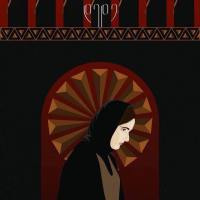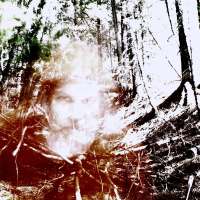Firebird Assoluta
(Note: The next few essays on Gravity From Above will deal with the music and dance of Georgia. This does not represent a widening of the documentary, but our interest in those things that still connect us to reality as puppets do. The music and dance of Georgia does this in ways our own more alienated music no longer can. I am working on an idea for a new documentary. Those reading GFA primarily for puppets I beg your indulgence and encourage you to follow us to the end of our journey.)

Nino Samadashvili as the Firebird at the Paliashvili Opera and Ballet State Theatre in Tbilisi
Tinatin Gurchiani drove me over to the security entrance at the back of the Tbilisi Paliashvilil Opera and Ballet State Theatre. She parked her car as most Georgians do, half on the sidewalk half off ,and left me the car to see if she could arrange a meeting with Nina Ananiashvili, the artistic director of the Georgia State Ballet company and one of the most celebrated dancers in the world. Tinatin did not know her, and did not seem to have any specific connections at the ballet, yet this was Georgia where the improbable might indeed occur. After about five minutes she returned. “There will be a press conference for the Firebird tomorrow afternoon at 2:30. Enter at the front.” Tinatin handed me a piece of paper with a name and phone number on it. “Ask for Tamar and she will let you into the press conference. You might be able to talk to Nina Ananiashvili then. After that you can watch the dress rehearsal and take photos.” I was impressed. Suddenly I was being allowed to get into a ballet rehearsal and perhaps get to meet a Prima Ballerina Assoluta. I would indeed be there.

Bronze Ballerina Statue in front of the Opera House
The next day I showed up a bit before 2:30 and found myself being escorted to the press conference by a blond haired woman who not Tamar. It was somewhat as you would imagine. Various Georgian media outlets were there to get the story about the recreation of Mikhail Fokine’s original version of the Firebird. Andris Liepa had directed it and Nina Ananiashvili had a big hand in the proceedings. They were there along with the conductor David Kintsurashvili and the two main principle dancers, Nino Samadashvili and Philip Fedulov. They soon came out. Nina was slightly taller than I imagined and had far longer legs. But of course that only makes sense. She is a ballerina to say the least of it. Smiles and Georgian words flowed and a touch of Russian. They were explaining that it was indeed an attempt at historical illumination. Cameras and video rolled. I took just a couple of photos, feeling like a fish out of its element. I was fascinated just to be a part of these doings. Soon the conference broke up. Nina and Andris were available for televised inserts. And the next thing I knew, after finding the Tamar I was meant to find, I was being introduced to Nina herself. I explained very casually that I was in Tbilisi working on a puppet documentary, but that my next project was on the music and dance of Georgia. She offered a five minute interview in a quieter room right then. But I held out for a longer possible interview on another day, besides I really wanted to see the dress rehearsal. She agreed and told me to arrange it with Tamar before Tuesday, when the troupe would be traveling to Italy and Spain with the Firebird.

- Left to Right: Philip Fedulov, Andris Liepa, David Kintsurashvili, Nina Ananiashvili
I then looked for the entrance to the recently renovated interior of the theatre. The stage sets glowed like the interior of a glacier as I stepped through a curtain down into the largely empty hall dazed as I was. I had seen dancers before when I lived in New York City but this was my first official moment at the ballet. I was dazzled by the site. Dancers were stretching, doing pirouettes, leaping across the stage as the orchestra tuned in the cacophony that leads to the beauty of a performance. I found a spot to sit fairly close to the front and immediately fumbled with my camera equipment to pass myself off as a qualified observer. Stravinsky’s primeval strains slowly swelled out from the orchestra pit. And I was still trying, often failing, to figure out the proper settings for the camera. I have often said that I can shoot interviews, but performance? That is a skill I haven’t yet mastered. And so this was a complete challenge for me. Nevertheless I did manage to find a few images that might give someone a small idea of what I had seen. The red Firebird figure danced in bright spotlight, while the background shimmered in deep blues and violets. I purposely didn’t try to follow the dramaturgy. Before I knew that I would be here on this day I had already bought tickets for the Sunday afternoon performance.

Inside the recently restored Paliashvili Opera and Ballet Theatre.
Sunday came and I entered the ornate hall surprised to find that not only was I attending the ballet that day but that with an olive green tie on my black button up shirt that I was actually overdressed. I looked around for one more man in a tie and did not find him. What I did notice, however is that the sold out opera house had an audience that was somewhere between one third to two fifths filled with children under 15, a large percentage of them young girls. Now this was a scene I couldn’t really imagine being replicated too often in America. Especially given American ballet prices! And what really surprised me, and which I understood more completely later when I was informed that that fully one third of all Georgian students had serious folk dance classes (we aren’t talking square dances here), was that the children really watched the ballet with some comprehension. They quieted down as the ballet started, though still occasionally whispering to each other when the ballerinas made a particularly beautiful movement. There were two teenage girls sitting next to me, who were wise enough not to applaud after every movement and were held silently, raptly, by the dancing. I could tell they were watching, not only as spectators, but as possible participants as well. And not only those girls! At the end of the ballet the audience erupted in applause and when favorite dancers came out to take their bows the young children cheered their favorites. And it was quite a sound. It was indeed the sound of children who knew what dancing was supposed to look like, who knew the difference between a good step and a great one.

Imprisoned maidens dancing before the demons in The Firebird.
The program itself featured three Fokine choreographed recreations, which added to my own idea of early 20th Century dance history. Besides The Firebird they also performed Chopiniana and Le Spectre De La Rose. But of course it was The Firebird that everyone came to see. And now I could relax and take in the story and dancing. And I was indeed fully captivated: The staging, the sets, the dancing and music fit together consummately. The fearful demonic creature Kashchei darkly realized. The white maidens shimmered. The nobles at the end conjured up a Caucasian fairytale. And the red Firebird flew hypnotically. And all to the majestic score by Stravinsky.

The demonic creature Kashchei. Has anyone made the Firebird into a puppet show?
As wondrous as the experience was it made me doubt slightly that I would ever get to talk to Nina Ananiashvili the next day. But on Monday morning I dutifully called Tamar who told me I could visit the theatre to see Nina at 5PM. I did not know how it would all play out, but I was dutifully at the gates of the theatre at the appointed time. I approached the guards. They knew nothing, nor spoke a word of English. I puzzled my next move. I need not have fretted though. At a couple of minutes after five a girl came out and escorted me passed security and up several flights in an elevator and within a few minutes I was greeted by a busy, but welcoming Nina Ananiashvili. Obviously with the troupe leaving the next day things had been hectic. I asked if I could film the interview. She sighed and said she wasn’t ready to filmed, but she had no problem with an audio interview. And so I sat back in her office in the dying daylight and discussed ballet, traditional dance and music, the Georgian custom of the supra, the effect of technology and modernity and its wastefulness upon Georgia and it’s culture. It turned into another defining moment of the trip. She was particularly glad that I pointed out the children at the ballet, since she had worked hard to expose the local kids to real ballet, not some simplified children’s ballet, but the real thing. She was also acutely sensitive to the need to preserve the depth of Georgian music and dance.

As Stravinsky’s music gloriously ascends the maidens are freed at the end of the Firebird.
I had come to Georgia to ponder the meaning of music and dance in our human ecological needs, and not the recordings of these things, but the continuing of deep traditions. Through Nina I realized where the traditions of music and dance really flourished. And that was in the supras. The supra is an extended meal that features much food, toasting, poetic utterances, music and even dance. It is in this humble institution that heart of Georgian folk tradition lay. She told me that the supra is the place of Georgia spiritual and psychological therapy, the place of laughter and tears and mostly of friendship. And by ‘friendship’ I was beginning to understand that Georgians meant something much richer than we Americans, even the best of friends, meant by the word. Had I been to supra yet? Nina asked. No I hadn’t. She then asked how long I was staying in Tbilisi. Till April 15th, I replied. We won’t be back yet, she said shaking here head. Next time you come! She offered. What could I say? I will have to come back! Oh understatement.

Even bows must be rehearsed







Pingback: A Theatrical Day on Rustaveli Avenue | GRAVITY FROM ABOVE